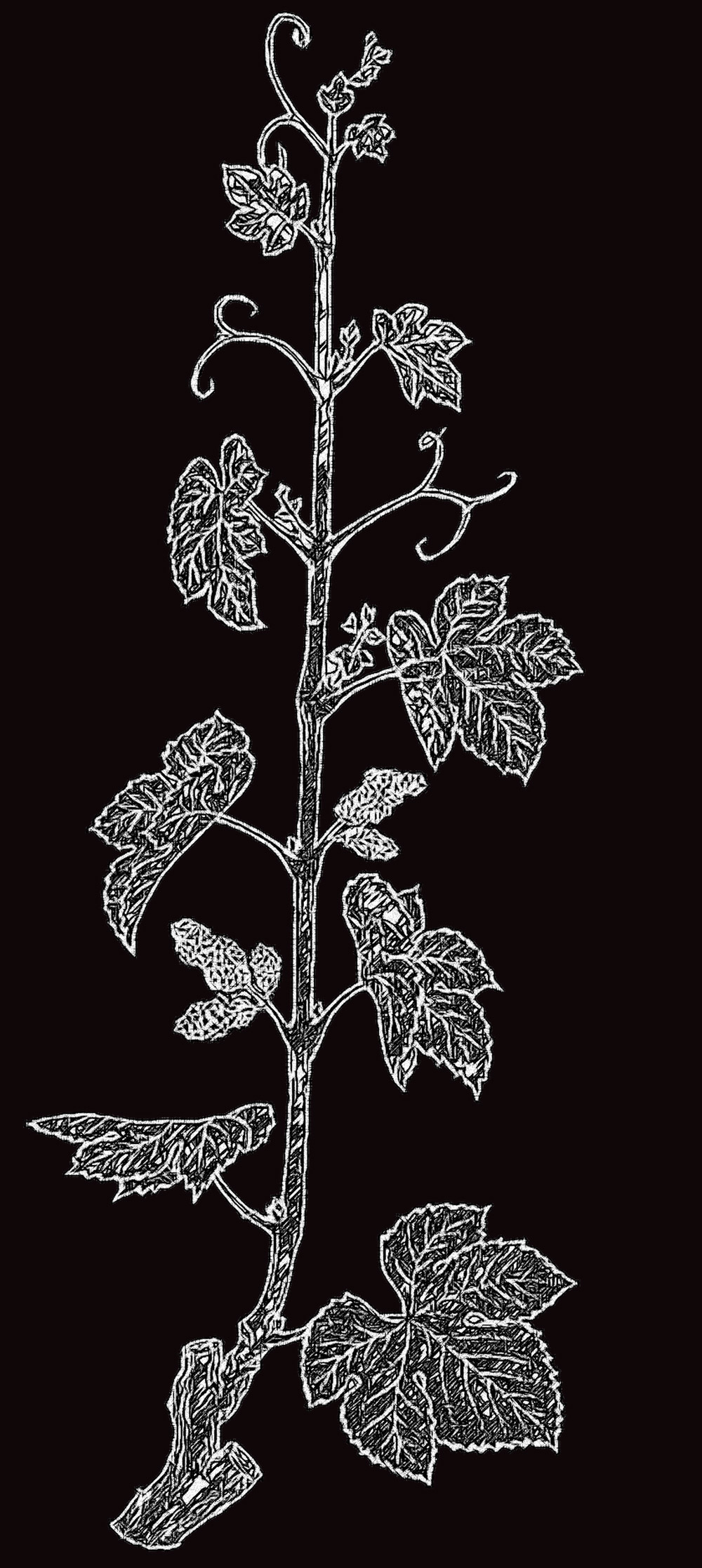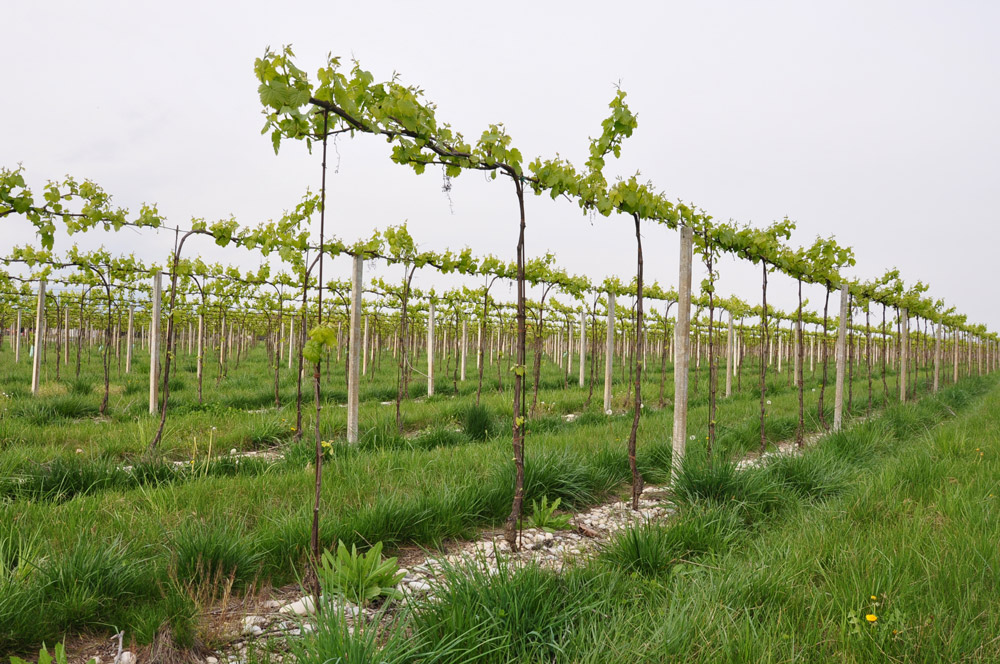The grapevine
The grapevine is an ancient plant. Fossil traces testify the existence of this vegetable species in the Cretaceous period, which is about 140 million years ago. When did man domesticate grapevine and discover that wine could be made out of it? Many researchers have it that grapevine cultivation dates back to the Neolithic period, 5000 years before Christ, when the first sedentary grapevines appeared. Witness the archaeological sites in Iran and Georgia, which have been concealing seeds, carbonised fragments of trunk, whole dried grapes and traces of tartaric acids, a compound that is almost exclusively found in grape, for thousands of years.
Around 70 species belong to the Vitis genus, which is divided in two groups: the American one includes about 30 low-quality disease-resistant species, which are mainly used as rootstocks or hybridised with Vinifera. The Eurasian one, (found between the Black Sea and the Caspian Sea, in countries such as Georgia, Armenia, and Azerbaijan), contains about 40 species, including Vitis Vinifera, which is the currently grown one. Vine varieties can be distinguished based on the different shapes and colours of their grapes, bunches and leaves, as well as on their different ripening periods and the different organoleptic features of the wines that are made out of them. To obtain a high-quality wine, the vine variety is chosen based on the area in which the very wine is to be produced. Indeed, the most successful wines of today are produced with grapes that have perfectly integrated in the local pedoclimatic environment. Specific growing and winemaking techniques are also required.
The term vine variety is not to be confused with vineyard, which is the productive structure devoted to the growing of grapes. Suffice it to think of the vineyards embellishing the hilly landscape of Conegliano and Valdobbiadene, which you can see in the pictures.
THE GRAPEVINE – is an arboreal plant with a climbing structure belonging to the family of the Vitaceae (from the Latin viere = interweaving/attaching), which includes approximately 1000 species divided into 17 genera, most of which are ornamental plants except for the Muscadinia genus and the Vitis genus. The latter one includes around 60-70 species distributed in North America (around 20) and Asia (around 40). In the Asian group, you will find the Euroasiatic species (Georgia, Armenia, Azerbaijan) called Vitis vinifera to which the varieties farmed today and native to the area between the Black Sea and the Caspian Sea belong to.
THE GRAPE – On the outside we find the skin (pericarp) composed of an epidermis where you find the cuticle covered by bloom (a wax which serves to protect the grape from atmospheric agents and parasites, as well as act as nutriment for the yeasts within and which will later be responsible for the alcoholic fermentation) and a subdermis made up of 4 to 16 layers of cells. The skin contains the precursors of the aromas, the colouring substances (flavonoids) and the tannins.
Then there is the flesh (mesocarp) where we find the sugars, the acids and other aromos as in some aromatic varieties like Muscat. Finally, there is the endocarp which covers the grapeseeds rich in tannin and oil. When the grape is ripe, the seeds are dark (because they are lignified) and crunchy like a coffee bean. The bunch is composed of an inflorescence on the ends of which you will find the elementary inflorescences made up of clusters of 3-5 grapes, also called berries, of different shapes depending on the variety (oval, round, eliptical, flat, etc.).


LEAF They can take on different shapes and are responsible for chlorophyll photosynthesis
THE GRAPE BUNCH is composed of an inflorescence or rachis with elementary inflorescences or pedicels made of clusters of 3-5 grapes, also called berries, of different shapes.
depending on the variety (oval, round, elepsoidal, flattened ecc.)
EPIGEOUS APPARATUS in other words, the vegetation which is visible above the ground
THE TRUNK of the grapevine which supports and conducts
HYPOGEUM APPARATUS (1-3 metres) or the root system: It is responsible for anchoring the plant to the ground and absorbing water and mineral salt

Rooted vines are small vine plants grown in nurseries and ready for grafting. They are made by grafting a shoot portion (also known as “scion”) of the mother plant (namely an “adult” vine) into a second shoot portion (known as rootstock), which the radical apparatus will stem from. In Italian, the young plant is named after the beard-like tap roots that grow out while the plant is in the nursery. All the above is possible thanks to the ability of the vine – and many other plants – to regenerate, which means autonomously rebuilding severed portions. Therefore, rooted vines are the result of the joining of two different portions (or bionts):
the radical apparatus will stem from the lower portion (namely the rootstock), whereas the upper portion (namely the scion) will constitute the aerial part. But why do rooted vines require grafting? This question requires us to travel back into time in order to be answered. In the mid-1800s, an American pathogen insect called Phylloxera almost wiped out European vines by attacking their roots. Several years were required to understand the cause of the problem and thus find a solution. Things changed when the radical apparatus of the American vine was discovered to be Phylloxera-resistant. Wine-growers started producing rooted vines by grafting American rootstocks into European vine scions. Once grafted, the future rooted vines undergo a forcing process in order to promote the healing of the graft point, and are placed in the field from April to December, for them to develop roots and the aerial part. They are removed from the ground and sold at the first signs of cold weather.
THE SEASONS OF THE VINE
After a long winter rest, the now bare vine slowly grows accustomed to the world of life. The beginning of a new year is symbolised by a tear. Wine-growing science defines this phenomenon as weeping: the roots suck in water in order to hydrate the plant and the bud, which is found on the shoot. The second phase is called budding. In order for the bud to become a sprout, an average temperature of 10°C is required, which the Glera areas usually reach between the last week of March and the first week of April. 50/55 days later, the blossoming phase will disperse pollen into the air together with pleasant, unmistakable odours recalling those of future wine. However, the future grape can be seen only during the setting phase, which is reached only by 40/55% of the flowers of our vine variety. The parts that are not involved in this metamorphosis slow down their expansion due to the ovaries in the very flowers not being pollinated. However, nature keeps following its itinerary towards life by constantly growing sprouts and leaves, until the veraison phase begins. The grape is translucid now. It is no longer green, and it has turned straw-yellow. Its content is ever less sour, as it starts producing sugar, namely the substance required for grapes to ferment and become wine. Enter the ripening, namely the balance between acids and sugars. The falling of leaves, which bears the plant again, is last phase before a new winter rest comes. The buds fall asleep, as do the roots, the activity levels of which drop. The cold season is at the door.
THE FORMS OF THE VINE
The grapevine is an arboreal plant that has a climbing structure requiring support in order to survive. For this reason, from as early as the Roman times, throughout central and northern Italy the vine would be paired with an arboreal plant and this union has lasted for two millenniums up to the arrival of the vine-pest in the mid-1800s. From that moment on, so-called modern wine-growing started, characterised by the use of vines grafted on American stocks, whose training is regulated with forms characterised by small-sized foliage supported by poles and, towards the end of the 1800s, also by steel wires. Given the elasticity of the stalk, the vine can take on the most various of forms and that is how it has been until after the Second World War, but in the last thirty years we have witnessed a profound change in the variety of the forms of growth; indeed, pressing needs to mechanize and rationalize production have drastically reduced their number and reduced the extension of others (see tendone/overhead vineyards or head-trained vineyards). The widespread tendency is to use an espalier either with a permanent cordon (see Sylvoz) or removable cane (see Guyot), with standard size and standard shaped foliage making it easier to manage the top leaves and use harvesting equipment. Regardless, every form requires the maximum amount of sunlight to reach the leaves and a good exposure of the grape bunches to the sun.
In the case of the cultivation of the Glera vine variety from which Prosecco wine is produced, there are four forms of training mainly used and this is due to the peculiarities of this variety (the fertility of the buds, the bearing of the vegetation, its robustness, etc.) and the local traditions, often a determining factor in the decisions that wine growers make.

Guyot
Used mainly in its “double” version, it is a training system which can guarantee a high level of quality.

Double upside-down
Used mainly in hilly environments, it is a variation of the double Guyot compared to which the two fruit-bearing ends are longer and curvier and re-grow every year.

Free cordon
Suitable for keeping setup and production costs lower thanks to the fact that mechanizationis easily adaptable, it is still a form of training which ensures a good level of quality.

Sylvoz
A system widely used mainly on the flat lands because it is suitable to the climate and soil types.
THE FUTURE
Vines: 19 pairs of chromosomes – around 30,000 genes = 487 million nitrogen bases
Man: 23 pairs of chromosomes – around 23,000-25,000 genes = 3 billion nitrogen bases
GENETIC IMPROVEMENTS – BREEDING
At the end of the 19th century, Europe saw the launch of crossing programmes between American and European vines, with the aim of making the latter more resistant to diseases, especially the three American pathogens that had devastated viticulture shortly before (namely powdery mildew, downy mildew and phylloxera). This goal was technically correct,
as American vines showed traits (later called genes) that enabled them to resist those diseases. American vines needed to be crossed with Europeans one without hampering
the quality and typicality of the European vine varieties. Ever since the end of the 1800s, many research institutes have been trying to obtain superior varieties by means of crossing and hybridisation, even though the results are always random and uncertain. A crossing is carried out between two vine varieties belonging to the same species (such as the Müller
Thurgau, a cross between Riesling Renano and Madeleine Royale), whereas hybridization involves different species, and thus requires the use of European and American vines. In
both cases, plants with the desired features are selected in order to create a new vine variety containing the positive traits of both parents. The development of biotechnologies and the recent decoding of the vine genome have enabled research to achieve amazing results, so much that molecular markers can now be used to accelerate the selection process carried out in laboratories, thereby making it more accurate, cheaper, and quicker. The possibility to apply new genetic techniques to enhance vines without considering any new vine variety as a GMO is currently being debated. These processes are called Cisgenesis (namely the cross between specimens belonging to the same species) and Genome Editing, the use of which is expected to be ruled on by the competent European bodies.
